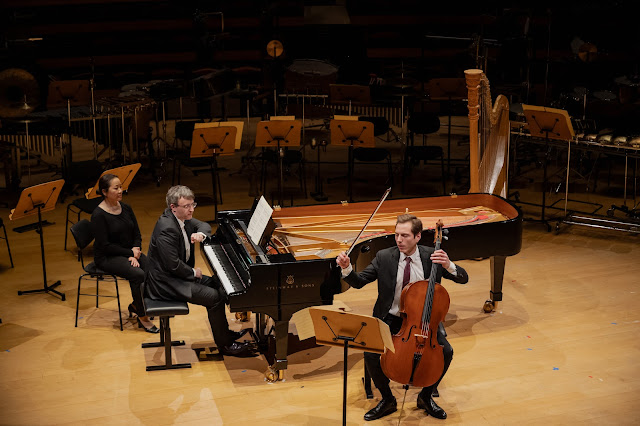Purcell Room
Boulez: Anthèmes 1
Benjamin Attahir: Retour à Tipasa
Philippe Manoury: Partita II
Layale Chaker: Before bloom
Kareem Roustom: Pavane (pour les enfantes défuntes) (UK premiere)
Boulez: Anthèmes 2
Michael Barenboim (violin, viola)
Michael Barenboim’s Sunday afternoon Purcell Room concert, given with Gilbert Nouno, offered not only a welcome new standpoint to the Boulez centenary celebrations, but also the United Kingdom premiere of Kareem Roustom’s Pavane (pour les enfantes défuntes), for viola and live electronics, Barenboim’s own commission for ‘something for the children of Gaza’. Words, music, money, anything at all may seem hopelessly insufficient in the face of genocide, and of course they are. That does not mean, though, that we should not bear witness as we can. Schoenberg’s A Survivor from Warsaw does not efface, let alone undo, what was done, nor does it intend to. Extending his father’s humanitarianism and indeed as much in the tradition of Edward Said, co-founder of the West-Eastern Divan Orchestra, Michael Barenboim, the orchestra’s longstanding concertmaster, has consistently shown great courage in doing so in the face of implacable opposition from German media and the German state. Indeed, to have given the work’s world premiere in Berlin just under a year ago, in the rare friendly space of the city’s Pierre Boulez Saal, was itself an act of witness.
An opening cry, far from histrionics, yet all the more powerful for it, spoke of something more fundamental—in more than one sense. Roustom’s piece takes its leave, of course, from Ravel’s Pavane pour une infante défunte, and specifically the absurdism of its title, an absurdism we have seen and heard, via Beckett and the debris of post-Holocaust art, inflicted on children in Gaza and beyond. Neither overtly representational nor overtly abstract, its hope in some sense to speak, perhaps to sing, despite and through trauma seemed woven into both piece and performance, as well as to our necessary reactions. That it ultimately approached Ravel and his piece themselves, without the slightest incongruence, itself seemed both absurd and necessary, electronics creating a strange piano echo of their own.
In a carefully planned programme, this Pavane stood as a counterpart to the first-half Retour á Tipasa for violin and electronics, by Boulez pupil (at the Lucerne Festival Academy) Benjamin Attahir, also following on meaningfully from Layale Chaker’s Before a bloom for solo viola. Both works bridged, like Roustom’s, ‘East’ and ‘West’, not in a banal cross- or inter-culturalism, but as a natural form of expression. The opening éclat – that indispensable Boulezian quality – of Attahir’s work, a dazzling pizzicato figure, was immediately bathed, magnified, and transformed in dialogue with an electronic penumbra that offered more of a sense of aural landscape, though not only that, than Boulez would have been likely to consider. North African melodic and rhythmic inflections – to our ears, they may sound Scottish, but that is our problem – evoke or hail, again without mere representation, the Punic-Roman-Algerian port of Tipasa. Shifting relationships between solo instrument and electronics, as well as a clear, dramatic overall trajectory bore their own witness: not necessarily one to be put into words, but no less important for that. Likewise, in Chaker’s solo piece, whose pizzicato ‘accompaniment’ and solo arco line – it is more complicated than that, but perhaps not entirely – seemed to me strangely, expressively to echo the world of Bartók’s rhapsodies for violin and piano. Originally composed for cello, it showed no obvious sign of transcription, benefiting from rich, variegated viola playing and, again, unfailing sense of overall line.
Philippe Manoury’s Partita II for violin and electronics came across as effortlessly – however much art conceals art – conceived for violin, electronics, and their joint capabilities: as ‘natural’ as Chopin writing for piano, or Mahler for orchestra. A magical realm of precision, consequence, and highly expressive potential and achievement radiated, Boulez-like, from the ‘solo’ instrument, although it is far from clear that ‘influence’ or at least inspiration, may not have run as much in the opposite direction. Both like and unlike a violin concerto, its nine stands’ worth of music was full of surprises that were anything but arbitrary, Barenboim’s virtuosity here as elsewhere so clearly in the service of the music one might readily overlook it—yet should not.
Opening and closing the programme were
Boulez’s own Anthèmes 1 and Anthèmes 2, the former for solo
violin, the latter its expansion for violin and electronics. In both, Barenboim
– and Boulez – made crystal clear from the outset the nature and contrasts of
the musical material: the figure from his …explosante-fixe… ‘kit’,
treated in almost sequential yet never predictable variation, and single notes
of long duration. It was their story, told in illuminated style that recalled old
‘anthems’ on the acrostic Lamentations of Jeremiah, consecutive Hebrew letters beginning
each verse. (Recall also Stravinsky’s Threni.) Performed with a keen,
yet never remotely flashy sense of drama, the works’ structure became form
before our eyes and ears. Serial-Bachian procedures redolent of the Musical
Offering and Art of Fugue, especially in Anthèmes 2, evoked
the instrument’s past and perhaps its future, proliferation pointing toward an
apparent eternity. Musical rays shone outwards from the violin; at other times,
the instrument sounded as if a single ray, albeit the brightest, from within a spectrum.
This is not spectralist music, far from it, yet the distance may not prove so
great as many of us may have thought. I was struck anew by surprisingly Messiaenesque
harmony at its centre, by the singular use of electronics in ‘real time’, by the
music’s multi-dimensionality. It felt as if the pages of Anthèmes 1 had
been opened, their notes, numbers, metaphorical flowers turning to the sun—and then
away from it, inspired, emboldened, given new life. There may or may not be
hope, but there is still music.





